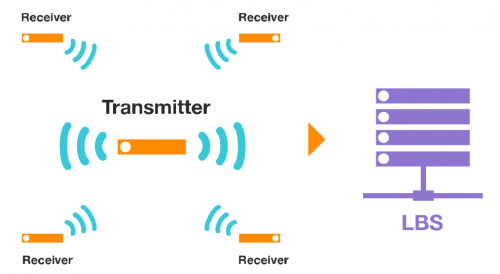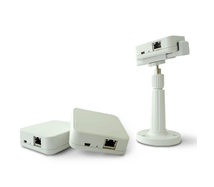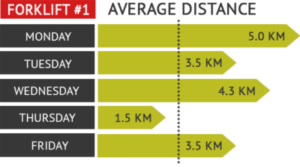Real‑Time Location System: Your Bodyguard
- Digital Factory
- Article
Imagine a warehouse where the workers don’t have to scan shelf positions and where the forklifts automatically avoid high-traffic spots so that they never have to wait and yield. Imagine a world where people are always notified when they enter an unsafe zone – perhaps a robot zone. Thinking of the future? Then think again. Welcome to the present – welcome to the world of Location Based Services.
Actually, we all know them. Location Based Services (LBS) work with data on your position. If you allow a phone app to access GPS data, it uses your location and lets you automatically e.g. save your restaurant visit and rate the restaurant. But how can you get object localisation into buildings, where GPS units can’t see the satellites and vice versa? Not easily – but Location Based Services (LBS) have long been making their way past this problem and into manufacturing and warehouse halls.

Aimtec - Location Based Services
Technologies for monitoring objects in real time inside of buildings were first brought out at the end of the 1990s. The era’s systems were based on RFID technology. However, the systems were too expensive overall for commercial use. But they were still revolutionary for the their time. As new communication technologies were developed, solutions became cheaper and more precise. As a result, we now can monitor not only objects’ positions, but their movements as well. That brings plentiful possibilities for monitoring data and outputs and provides the foundations for optimising internal-logistics processes – and warehousing itself.
Real-time location system
At first sight, an RTLS system overall resembles GPS. You have a signal transmitter (a chip, or if you’d like, a tag) that sends information to a receiver over UWB (Ultra-Wideband) technology. For GPS, a satellite would be waiting for signals, while for RTLS, it’s something called an anchor. Multiple anchors are generally needed in order to cover a space, with their exact count depending on how large and broken-up it is. These anchors pass on information to a special program that calculates how far a tag is from an anchor based on the difference in how quickly the signal reaches the individual anchors. With today’s technologies, that program can manage this with a precision in the tens of centimetres. While that might not sound precise, in a hall several thousand square metres in size, that’s an acceptable deviation.

Anchor, Source: Sewio
Key benefits of RTLS
So what we have here is a world where you can monitor practically anything in motion in your spaces, if it’s tagged with a chip. But… do you need to? Maybe so. Let’s take a look at two of the most typical things people associate with factory halls: forklifts and pallets.
Handling equipment has been an essential assistant in warehouse operations for almost a whole century: the first modern forklift that could “stack” goods was used in 1926. But even in 2018, forklift fleets are still often used sub-optimally. Some of a plant’s forklifts may sit out part of a work day while others never catch a break. Since a single forklift’s purchase price can run up to the tens of thousands of pounds, it’s clear that getting full use out of them is a major goal. RTLS systems will give you a complete overview of your fleet, including several types of information and visualisations for them. This information includes an overview of your forklifts’ overall lengths of use. That way you can immediately see if half your fleet is lying unused for two days a week.

Fleet utilisation. Source: Sewio
A heatmap for your hall provides useful information as well. It enables you to analyse the bottlenecks at your warehouse. An intuitive map in which you can see where forklifts are showing up the most often, or where they’re running into delays – or even minor accidents – is a secret weapon for a warehouse’s efficiency. Together with other systems such as a Warehouse Management System, they let you plan and optimise warehouse workers’ routes and your fleets (or just the fleets, for automated warehouses) to make the whole operation smoother and more efficient.
Pallets. For many people, they’re the most “warehousey” thing of all. Pallets generally see acceptance scanning just after entering the warehouse gate, and then position-code scanning after they’ve been stored. But what makes RTLS attractive is that you don’t have to enter locations manually. So your workers don’t carry scanners, and they’re not reading positions from shelves and then from goods for every operation. The chip on a pallet easily determines its location (usually including its height), and if the goods are then transported to a different position or to the production hall, once again the anchors can tell based on the chip where the given goods are going.
And what else? We definitely shouldn’t forget about people. The march of automation hasn’t yet driven people out of warehousing and manufacturing spaces, and it never will. For people, Location Based Services can be an invaluable bodyguard. You see, robots are appearing as helpers in hall spaces more and more. Special settings and the monitoring of people’s movements within a hall can trigger an alarm or even turn off the robots if a person approaches them and could thus be injured by them. After all, safety should always come first.
Want to learn more about the possibilities of Location Based Services? Follow our series. Or just contact us to arrange a brief, no-obligations meeting.
Share article
Top stories from logistics, production and IT.
Subscribe to Aimtec Insights
By registering, you agree to the processing of your personal data by Aimtec as described in the Privacy policy.
Get top stories and articles
from Logistics, Production and IT.
Subscribe to Aimtec Insights
By registering, you agree to the processing of your personal data by Aimtec as described in the Privacy policy.







